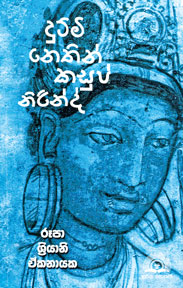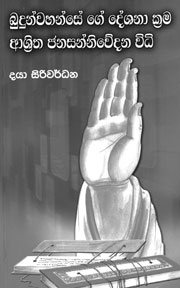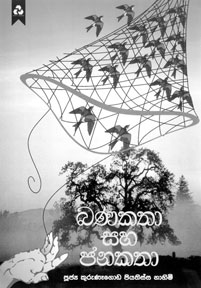|

Portrayal of artistic legacy, spirit and pattern of exciting milieu
Reviewed by Ranga Chandrarathne
Marked for clarity of expression and easy-to-read style, the novel
explores the fascinating facet of history in which the rock fortress
Sigiriya was built. It was also the time of chaos and confusion amidst
change of governance. It was also an era dominated by conspiracies,
patricide and power politics.
The author has maintained an impressive syntax and contextual clarity
which textures the plot into its diverse territories. Within the
narration, intersection of contemporary language and the language of
Kassapa's era can be found in dialogues of Arjuna with king Kassapa and
characters peopled that era. But this has not harmed the communication
of Arjuna with others. Author skillfully addresses the collective
consciousness referring to Uththara in the previous existence similar to
Subhani. In a subtle manner, the sub-conscious of characters including
those of Arjuna, Subhani have been explored. The novel may subject to
many readings from diverse perspectives.
 |
|
Dutimi Nethin Kasup
Nirind
Author: Rupa Sriyani Ekanayake
Sooriya Publication |
In terms of language, the author through her novel and innovative
usages has contributed to the enrichment of contemporary Sinhalese
idiom.
Set against that period of history in which king Kassapa built the
citadel of Sigiriya, the book explores the artistic aspects of king
Kassapa who is described as patricide. The narrator of the story is
young and enthusiastic archaeologist Arjuna who is obsessed with rock
fortress Sigiriya and unique artistic legacy of king Kassapa.
Dutimi Nethin Kasup Nirind( I saw king Kassapa), the latest novel by
Rupa Sriyani Ekanayake offers a literary expedition into the Kassapa's
era. Although it is a historical novel, it vividly depicts the life in
Kassapa's era with minutest details.
While working on a project on Sigiriya, Arjuna meets a visiting
Indian Professor Vinod who has been researching on time travel. By
accident, Arjuna goes back to Kassapa's era and witnesses the history
unfolding before his eyes. Although he intends to alter the course of
the history, he miserably fails and becomes a passive witness to
unfolding events. The novel ends with Arjuna's return to the present.
The author skillfully recreates Kassapa's era with a convincing account
of life in the era. The author is at best in descriptions of Sigiriya. "Uththara
and I stayed in the veranda of a small building which was more beautiful
than the palace.
The room was built like a replica of a small palace that was
extremely beautiful. The walls of it shone brightly as if golden dust
had sprayed on them. A wooden parapet wall with intricate carvings was
fixed around the room. The veranda too was spread around the room so as
to enjoy the breathtaking view of crystal clear water in the ponds while
walking through it. The reddish wooden pillars held its roof. Around the
roof ran a lotus pattern in wood carving. The garlands of flowers came
down from the carved wooden beams in the roof of the veranda. Those
garlands were made by the concubines in the harem to welcome the king on
being heard that king would come for aquatic sports. Uththara looked
around to enjoy the beauty of the room…" (Page 303)
Research into the Kassapa's period
From the elaborate passages on the events in the history of Sri Lanka
in general and on king Kassapa's era, it is obvious that the author has
done extensive research on the life and times of king Kassapa and his
citadel of Sigiriya. According to the history king Kassapa built the
rock fortress in the period of 477-495 AD.
The Mahavamsa says that king Kassapa killed his father, king
Dhatusena, by walling him alive over the throne which rightfully
belonged to his brother Moggallana. Moggallana fled to India and
returned later with a mercenary army. One school of thinking is that
Kassapa built the rock fortress to defend himself from possible invasion
by Moggallana. It was said in the battle, the army deserted king Kassapa
and he committed suicide. Moggallana who took the throne made once again
Anuradhapura the capital converting Sigiriya into a monastery.
The novel covers the period in which king Kassapa built the Sigiriya
and his reign until the invasion of Moggallana. The author has used
first person narrative to describe the journey into the past and to
portray the character of king Kassapa as a sensitive art lover who
enjoyed his life with his concubines in the citadel of Sigiriya. The
novel also touches on the peripheral themes such as reincarnation and
eternal bondage in young couple. The book is noted for its rich language
and the use of contemporary Sinhalese idiom. The author has adapted
Sinhala language of Kassapa's era to convey a sense of the period.
A historical novel
According to Encyclopedia Britannica, a Historical novel is, " a
novel that has as its setting a period of history and that attempts to
convey the spirit, manners, and social conditions of a past age with
realistic detail and fidelity (which is in some cases only apparent
fidelity) to historical fact.
The work may deal with actual historical personages...or it may
contain a mixture of fictional and historical characters."
The novel not only is based on a historical person but also attempts
to convey the spirit, manners and social conditions prevalent in
Kassapa's era. Although the genre of historical novel is not uncommon in
Sinhalese fiction, very few authors ventured into this genre owing its
complexities and challenges.
The author's device of Time Machines though not a common concept in
Sinhalese fiction, has served the purpose of exploring the Kassapa's era
in an innovative manner. It seems that the author has exercised care in
not allowing the scientific aspects to take precedence over the
aesthetic aspects of the plot.
The author has purposefully introduced the Buddhist concept of
rebirth in order to establish a strong bond between the couple. In a
way, it has added spiritual elements to the story. The Buddhist monk who
appeared in both Kassap's era and in the present era functions as a
conduit of convincing the reader.
The inclusion of the Time Machine seems to be out of touch with the
sequence of the events although it may not be completely alien to
Sinhalese readership. For instance, if the author has used meditation as
a means to visit the past, it could have been a more convincing method.
The structure of the novel is not so impressive. It is one of the
weaknesses otherwise it would have been more impressive.
The monk advises Arjuna to give up his futile attempts to change the
course of history reaffirming the Buddhist belief of Kamma (cause and
effect).
The ending of the book is dramatic and inconclusive leaving the
reader to decide on whether Arjuna has really travelled into the past or
Prof. Vinod hypnotised him or the entire journey into the past is a
pigment of his imagination. The novel offers a rare insight into the
artistic aspects of the legendary king Kassapa and 'spirit, manners and
social conditions 'of the era.
Focus on Buddhist communication methods
Reviewed by R. S. Karunaratne
The Buddha was one of the great religious leaders who understood the
value of mass communication methods to propagate His doctrine. One of
the basic principles of mass communication is that the communicator
should know what he is going to communicate. Secondly, he should know
his target audience. Thirdly, he should know the method of
communication. Fourthly, he should be aware of possible feedback from
the audience. Finally, the communicator will have to realise the impact
of his communication.
 |
|
"Budunvahansege
Deshanakrama
Ashritha Janasannivedana Vidhi"
Author:
Daya Siriwardane
A Godage publication |
Daya Siriwardane in this book has explained the Buddha's
communication methods and compared them with mass communication
principles. To do this effectively he has sought the help of definitions
used in mass communication and their relevance to the Buddha's methods.
Accordingly, he has come to the conclusion that the Buddha's
communication methods were more effective than modern communication
methods. The ultimate aim of the Buddha's communication was to enlighten
the audience. This is going beyond the information oriented methods used
in modern mass communication.
The Buddha had the advantage of reading the mind of His listeners. A
modern communicator is not gifted with this faculty. As a result, the
Buddha's communication was tailored to the needs of each individual. For
instance, He knew whether a particular person was in the correct frame
of mind to understand his doctrine. If the listener was hungry, he had
to be given food before delivering a Dhamma Deshana. On the contrary,
modern communicators do not know whether their listeners are in a
suitable position to understand the message.
Except on rare occasions, the Buddha addressed mass audiences. His
message was for the benefit of the majority of listeners.
What is important to note is that His message is timeless. It is
valid for any time in the past, present or future. He also knew that the
message should be delivered in a methodical manner. He was assisted in
this task by erudite members of the Maha Sangha.
The Enlightened One used many stories to explain his message. Even
modern communicators resort to this method to drive home an important
point. The Buddha also had tremendous energy to speak without fear of
favour.
The Buddha knew four types of people who came to listen to Him.
Firstly, there were people who could understand anything very quickly.
However, they failed to grasp the significance of the communication.
Secondly, there were people who had the ability to solve problems but
they failed to understand the reasons. Thirdly, there were those who
could express themselves clearly. Unfortunately, they did not realise
the significance of the message. Fourthly, there were people who did not
understand what they listened to. They also could not explain what they
had learned.
Daya Siriwardane's book, although small in size, opens up new
frontiers for those who follow mass communication courses and others who
are interested in Buddhism.
Story for pleasant reading
Reviewed by Rev. Fr. Joe de Mel
This is a short story. The author uses the names of Biblical
personages including Jesus of Nazareth for the characters in his story.
Yet, he is keen at the outset to make known to his readers, that he is
not taking into account "the divinity ascribed to Jesus on which is
based the entirety of the Christian religion." However, the book takes
for granted the Resurrection and Ascension of Jesus. Futher he tells the
reader that in fiction vivid pen portraits of the characters are given
but in the Bible "the World's No. 1 best seller" no such portraits are
given. In the story the author creates such portraits, as the story
itself totally from imagination. Readers especially Christian readers
should thus not quarrel with him that he is not true to the Bible. It
may be queried what value is there in such historical fiction? The value
has to be determined not from a religious point of view but from a
literary point of view.
 |
|
Ecce Homo
Author:
John Weerasinge |
Jesus is presented as a physically strong human being with a beatific
smile whose personality has a soul stirring effect on those who
encountered him, including the chief character in the story Claudia, the
wife of Pontius Pilate the Roman Governor of Judea who condemned Jesus
unjustly against his better judgement.
The title of the book is a statement made by Pilate during the trial
of Jesus as recorded in the Bible, "Behold the Man".
Claudia is presented as an independent strong willed women with a
mind of her own; having the mentality of a modern day empiricist. She is
not satisfied by the hearsay news circulating about the Resurrection and
Ascension of Jesus.
She sets out to investigate matters for herself. She is one who is
deeply impressed by Jesus but before she can reach a final conclusion
about Jesus her own world collapses and brings an unexpected end to the
story.
The author in the last paragraph of the Foreword states "the queries
raised by Claudia create riddles about the death and resurrection of
Jesus of Nazareth, riddles which are baffling and which even his
followers find difficult to answer. Perhaps no one is expected to answer
them!" I quote Fransz Werfel in his book "Song of Bernadette" as being
apposite by way of comment. "To those who have the Faith no explanation
is necessary. To those who do not have the Faith no explanation is
possible.".
The story is well written. It moves smoothly and quickly. It engages
the interest of the reader and holds it. There is a certain purity and
simplicity of style that puts the reader in contact with the characters
and scenes described, which makes for pleasant reading.
Monument to a great king
Reviewed Daisy Abey
Having lived in England for half a century, reading P.G. Punchihewa's
new book 'Mahasenapathi Dutugemunu Rajatuma' made me feel nostalgic. We
live today with tomorrow to come but the past stays with us. This book
is a fine piece of scholarship and a fascinating narrative. This story
is a segment of the ancient history of Sri Lanka over 2000 years ago
about King Dutugemunu, who was also the Commander in Chief with wide
experience and knowledge of war and peace.
 |
|
"Maha Senapathi
Dutugemunu Rajatuma"
Author:
Dr. P.G. Punchihewa
A Sarasavi publication |
This was the age when elephants, horses, bows and arrows, spears and
shields were the weaponry of strong men on foot in field combat. The
author describes in great detail the many years of preparation for the
battle of Vijithapura, developing rice cultivation for food, clearing,
re-constructing and strengthening the road to Anuradhapura wide enough
to take his vast army. Throughout his long term plan to fight the
invader to establish a united state and protect Buddhism, the king had
enormous support from his mother Viharamaha Devi and from the Maha
Sangha. His father, King Kavantissa, had laid the foundation for his
powerful personality. This was not a narcissistic power-seeking war. As
a 12 year old child Dutugemunu had a passionate desire to save Buddhism,
a path along which his parents strongly encouraged him. He decided to
fulfil his plan by commencing combat against an equally powerful force
and he succeeded in defeating the Tamil king Elara, who ruled for 44
years. It is said that both the Tamil King Elara and Sinhala King
Dutugemunu were rational, kind, strong and popular.
Punchihewa's account of King Dutugemunu's fight with opposing force
provides an amazing documentary, enriched by historical detail and the
author stresses his moral qualities, his immense respect for the dead
King Elara, whom he defeated in single combat, the funeral arrangements
he made and the monument he built. This was a rare event in the world
history and until Punchihewa's book it has never received such in depth
treatment. The singular tale of the strong, powerful and loyal elephant
Kandula, who destroyed the iron doors of the enemy fortress, is
exciting. After the war ended the king began to build a series of
massive religious monuments.
The Ruvanweli Dagaba still remains and stands mejstically in the
backdrop of multicoloured evening clouds of the Anuradhapura sky and is
respected and worshipped daily by thousands of pilgrims. King
Dutugemunu's reign lasted 24 years; after his success in battle he
devoted his life to the protection of Buddhism. Although his life and
his disposition were extraordinary he was, as an individual, very humble
and ready to work in rice fields alongside the peasants, helping to
build tanks and watercourses for irrigation and cultivation. According
to legendary tales and inscriptions he married a beautiful woman from
the Kothmale area while he was living incognito there.
The author has researched his sources in detail and the bibliography
is exhaustive. Every source has been tapped and the result is that one
of the most interesting ancient monarchs of Sri Lankan history has a
biography in which his life and achievements are set out.
The book is a monument to a great king, a historic tour-de-force
which adds a pertinent and timely contribution to education. The quality
of the language is simple and lucid and at a time when national unity
needs to be re-established this publication is apposite. A translation
of this book into English would be greatly appreciated particularly by
the Sri Lankan expatriates.
The writer was born in Sri Lanka and now lives in England. She is a
bilingual poet in English and Sinhala. Her novel "Like the Wind" first
published by Sixties Press U.K. and then by Vijitha Publications was
placed among the first ten of the Sorelines 2001 Competition. Her other
works include "Sharp Edge" and Under Any Sky", two books of poetry)
New arrivals
'Vivaha Vanne Ei'?
A Sinhala book entitled 'Vivaha Vanne Ei?, written by K.D.C. Perera
was launched recently.
 When compared with the days gone by, today we see an increase in the
number of marriage failure, and this is happening with in the first few
years of life. When compared with the days gone by, today we see an increase in the
number of marriage failure, and this is happening with in the first few
years of life.
Women who fail in separation spend a miserable life thereafter. The
main reason for such failures is the inability to find the most suitable
partner.
Failure at this point leads to a series of other problem right
throughout life.
Some of the topics found in this book are: Is love marriage
preferable to a proposed one?
Is your first love a sleeping volcano?
How to cope with your mother-in-law?
How to avoid children being born with birth defects? Is the absence
of Virginity (sometimes at birth) a social disgrace?
How does conception take place? The book has 23 such interesting
topics.
The author has served the Health Dept. both as a Health Education
officer as well as a Senior Lecturer in Public Health.

"Bana Katha Saha Janakatha"
Ven. Kurunegoda Piyathissa Thera's latest book on Buddhism entitled "Banakatha
Saha Janakatha" will be launched at the New York Buddhist Vihara, United
States of America on September 2 at 10 a.m.
The book will also be available for sale at Dayawansa Jayakody
Bookshop, Ven. S. Mahinda Mawatha, Colombo 10 on the same day.

"Appuva Rajawu Heti"
Prof. Dileep Chandralal's "Appuva Rajawu Heti" will be launched at
the Sri Lanka Foundation Institute Auditorium, Independence Avenue,
Colombo 7 on September 6 at 3 pm.
The book is published in Japanese, English and Sinhala.

"Kalayata Amathakavu Deshaya"
Ananda Sellahewa's "Kalayata Amathakavu Deshaya" is the authentic
Sinhala translation of Edgar Rice Burrow's popular novel "The Land that
Time Forgot".
This is a Sooriya publication. |

